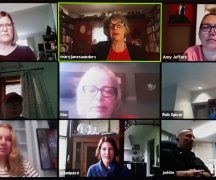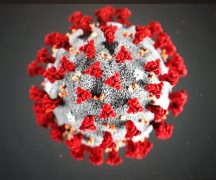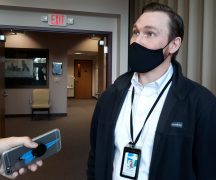By JAN LARSON McLAUGHLIN
BG Independent News
Halloween is posing a COVID quandary for many households. Are there any twists to the typical trick or treat that can make it safer for those giving and getting treats?
Some creative solutions have been suggested by Bowling Green residents on Facebook.
Several are considering long packing tubes to create candy chutes. In order to not touch the candy at the top of the tube, one person suggested using a scoop.
Another person toyed with the idea of using something similar to a T-shirt shooter used at athletic events. “What could possibly go wrong,” she commented.
Then reality crept back into the picture.
“I can just see the headline now – ‘Local woman injures child shooting candy into Halloween bag,’” she said.
Her plan B – hanging candy from a clothesline.
People should be thinking of non-traditional ways to handle trick or treating this year, according to Alex Aspacher, community outreach coordinator with the Wood County Health Department.
“Take steps to make it safer,” Aspacher said. “Do anything you can to make it contactless.”
Instead of handing candy out at the door, consider hanging treat bags on a fence, or placing them on the steps or walkway.
“Do more to maintain that distance,” he said.
For families out trick or treating, the rules should be different this year.
“Don’t have your kids reach into a bowl. Make sure your kids understand the importance of sticking with people in their family,” Aspacher said. “Figure out how to make it fun.”
Once home with the sugary loot, parents should wipe off the candy wrappers with sanitizing wipes. And for this year, homemade treats should be avoided, he said.
For families who want to skip trick or treating all together, there are other Halloween options. The holiday can be celebrated with an Easter twist by hiding candy inside the house, or outside in plastic eggs. A Halloween scavenger hunt can be organized, a virtual costume contest and pumpkin carving, and a Halloween movie night at home.
“We’ve just got to figure out how to do things differently this year,” Aspacher said.
Bowling Green’s trick or treat has been scheduled for Oct. 31, from 6:30 to 8 p.m.
Aspacher also advised that people avoid large Halloween parties.
“So many cases we see are from people getting together,” he said of local COVID-19 cases.
No activities like bobbing for apples should take place. And the standard rules apply – wear a cloth mask, wash hands often and maintain social distance.
“Just because you’re wearing a mask doesn’t mean it’s safe to be within 6 feet of people,” he said. “Maintain your distance from people you don’t live with.”
Following are some suggested from Responsible RestartOhio on how to celebrate Halloween:
• It is strongly recommended that hayrides, haunted houses, and trunk-or-treating events be canceled/avoided.
• It is strongly recommended that Ohioans exercise caution when deciding to participate in trick-or-treating and other events that put them in close contact with people outside their households. According to the CDC, traditional trick-or-treating, with treats handed to children who go door-to-door, is a high-risk activity and should be avoided.
Consider lower- or moderate-risk, socially distant ways to celebrate, such as:
• Holding a drive-through or drive-in trick-or-treat event, with children in costume and face coverings staying in cars and collecting treats from individuals spaced at least 6 feet apart.
• Holding drive-by costume or car-decorating contests with judges who are physically distanced.
• Leaving treats for friends and neighbors.
• Carving/decorating pumpkins with members of your household and displaying them or carving/decorating pumpkins outdoors, at a safe distance, with neighbors or friends.
• Holding costume parties or pumpkin carving events or contests online, such as by video conference.
• Hiding treats outside your home as an alternative to trick-or-treating.
• Holding a Halloween scavenger hunt, giving children lists of Halloween-themed things to look for while they walk outdoors from house to house.
• Holding a scavenger hunt-style trick-or-treat search with your household members in or around your own home.
• Having a Halloween movie night with people you live with or having an outdoor Halloween movie night with local family friends and people spaced at least 6 feet apart. If screaming will likely occur, greater distancing is advised.
• Do not hold large in-person Halloween parties. If holding smaller parties, limit attendance to 10 or fewer people and hold the event in an outdoor area where social distancing is possible.
• Avoid activities, such as bobbing for apples, that foster the spread of infection.
• Always wear a face covering and stay 6 feet away from people who are not from your household, whether trick or treating, passing out treats, or attending attractions or events.
• Face coverings should never be placed on children younger than 2 or anyone who cannot easily remove them.
• A costume mask is not a substitute for a cloth mask. A costume mask should not be used unless it is made of two or more layers of breathable fabric that covers the mouth and nose and doesn’t leave gaps around the face.
• Do not wear a costume mask over a protective cloth mask because it can be dangerous if the costume mask makes it hard to breathe. Instead, consider using a Halloween-themed cloth mask.
• If you may have COVID-19 or may have been exposed to someone with COVID-19, you should not participate in in-person Halloween festivities and should not give out candy to trick-or-treaters.
• Carry hand sanitizer and use it often, especially after coming into contact with frequently touched surfaces and before eating candy.
• Select events/attractions that are held outdoors and allow attendees to stay in their cars (such as drive-through events with displays) or socially distance. Avoid events that involve being crowded in a small area or coming into contact with/being touched by others.
• Consider the people in your household who may be at greater risk of complications if COVID-19 is brought into the home, such as those with certain health conditions, women who are pregnant, or older family members.
• Refrain from having children select their own treats from a bowl/common container or set up a hand-sanitizing station.
• Consider lining up individually wrapped goodie bags on porch steps, a table in the driveway, or the edge of the driveway or yard with a sign asking children to take only one. Or use other creative ways to distribute treats, such as using a candy “slide” made of PVC pipe, or hanging treats from a wall or fence.
• If you are preparing goodie bags, wash your hands with soap and water for at least 20 second before and after preparing the bags.
• If taking your children trick-or-treating, limit the number of houses you visit and ask your children to stay as far from treat-givers as possible. For small children, consider holding the bag for them.
• Wipe off candy wrappers with sanitizing wipes when you arrive home.
• Allow children to eat only factory-wrapped treats. Avoid homemade treats made by strangers.
• If your child is at greater risk of complications from COVID-19, contact your doctor before allowing participation in Halloween activities.





